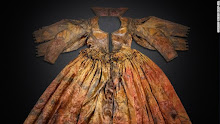Enjoy the last of the 11-part series of WHY ROYAL WEDDINGS MATTER celebrating the marriage of Prince Harry and Meghan Markle. "The Honey Month"....posted on Confluence Daily and reprinted below! (Most articles in the series are excerpts from my book, The End of the Fairy-Tale Bride.)
...............................
The Honey Month
In our world of extreme
media scrutiny, I love that the most famous newlywed couple on the planet took
what appears to be a private honeymoon!
“With the world watching,” wrote Elise Taylor of Vogue, “Prince Harry and Meghan, Duchess of Sussex, seemingly did
the impossible: They snuck away on a two-week honeymoon.” (And, as of this
writing, the media can only speculate on the location!)
The word “honeymoon,”
in use since the sixteenth century as British historian Ann Monsarrat explains,
is a derivation of a much older term, “honey-month,” describing the first weeks
of the newlyweds’ life together at home, or at the home of friends or family,
with the not so subtle intent of ensuring offspring. But these were considered
rather “low-class words.” So, beginning in the eighteenth century, when it
became fashionable for well-to-do couples to take some sort of trip following
their wedding festivities, the occasion was called “going away,” thought a more
genteel expression.
“Going away” became
“the bridal tour” for the wealthy in the nineteenth century. For the British
upper-crust, the fashionable thing was to do a tour of the Continent; for
affluent Americans of the gilded age, it was to go abroad on a luxury ocean
liner then visit the most exotic sites of the day recommended by Baedeker.
It is “sweet, like true love, and delicious, like carnal love,
honey can be treacherous and sticky, like false love,” the author asserts. And
there’s more. Its thick, syrupy-ness brings up a “dark side of human
desire”—like this from Proverbs in the Bible: ‘the lips of an adulteress drip honey and her tongue is smoother than
oil’. Yet “pure honey is precious and good, like married love”—as this line
from the Highlander poem, Rob Roy, by
Andrew Lang suggests: ‘Or will ye be my
honey? / Or will ye be my wedded wife?’
Some believe the
term “honeymoon” relates to the ancient Viking ritual when, for their
aphrodisiac effects, “the bride and groom would eat honeyed cakes and drink
mead for the first month of their betrothal”—quite the honey-month! However, the connection to honey and the name
honeymoon or its true meaning “cannot be agreed upon,” Wilson continued. Like
most early wedding rituals there are hazy origin myths, but what we know for
sure is that “the use of honey in marriage rites has been a constant throughout
the Indo-European world, and beyond.” For instance, in an age-old Egyptian
marriage contract, the husband promised his wife a yearly gift of twelve jars
of honey; in archaic Hindu wedding ceremonies, the author added, “the bride’s forehead,
mouth, eyelids, ears and genitals were anointed with honey.”
Do we really ‘fall in love’ or do we just ‘fall
into a honeypot’? Do we meet our beloved by chance or are we stung by Cupid’s
honey-soaked arrow? In stories of mythology, honey plays its delicious part in romance.
Becoming known as the young god of love, Cupid—the son of Venus, the Roman
goddess of love, and Mars, the god of war—is not only famous for stealing
honeycombs, but he also “fires arrows at his victims, sometimes dipped in
honey” and they instantly fall in love with the next person they meet. Honeypot, indeed!
Here’s wishing Harry and Meghan many “honeyed”
years of marriage! ~
[Excerpts
from The End of the Fairy-Tale Bride: For
Better or Worse, How Princess Diana Rescued the Great White Wedding. Available
on Amazon.]


























